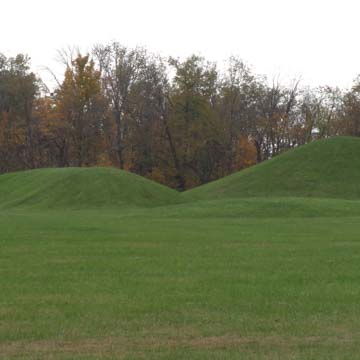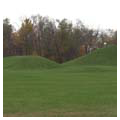You are here
Hopewell Earthwork Mounds
Concentrated in the Scioto River Valley near the present-day city of Chillicothe are several Hopewell Culture sites of earthworks and mounds in the form of circles, squares, and other geometric shapes. Hopewell Culture National Historical Park includes six earthwork complexes: High Bank Works, Hopeton Earthworks, Hopewell Mound Group, Mound City Group National Monument, Seip Earthworks, and Spruce Hill Earthworks. These sites were built at a monumental scale, with earthen walls up to 12 feet high outlining geometric figures more than 1,000 feet across. Conical and loaf-shaped earthen mounds up to 30 feet high are often found in association with the geometric earthworks.
Echoing the hills, valleys, and waterways that characterize the central Ohio River Valley, the Ohio Hopewell monumental mounds and earthworks are distinctive in their scale and complexity. They are unequalled by other ancient architectural monuments—the Great Pyramid would easily fit inside the Wright Square at Newark Earthworks or the square earthwork at Seip in Hopewell Culture National Historical Park; almost 10 of these colossal structures would fit inside the main enclosure at Hopewell Mound Group. Demonstrating the creative genius of the peoples of the Hopewell Culture, their monumental earthen architecture was constructed to exacting geometric and astronomical specifications. Used for mortuary rituals and religious and social ceremonies, the perfect circles, squares, and other geometric forms exhibit precise dimensions that are repeated at sites located far from each other and are accurately aligned to reflect the movements of the sun and moon. Also evident here is the ceremonial use of exceptionally finely crafted objects fashioned from exotic raw materials obtained from far-distant lands: copper from the Great Lakes, mica from the Appalachians, marine shell from the Gulf Coast, even obsidian from the Rocky Mountains. The presence of these materials indicates that the Hopewell Culture was part of a larger group of more permanent communities based on agricultural productivity and regional exchange.
The mounds lie at the core of ancient Hopewellian culture. Hopewell people lived in riverine, woodland societies as builders who expressed their worldview in a ritual landscape of earthen mounds. These earthworks were a material expression of the Hopewell peoples’ regionally integrated relationship to land and river and a powerful demonstration of their access to resources and raw materials for ritual purposes. The earthworks reflect the belief that the Hopewell people were at the center of the cosmos where two realms intersect: the horizontal earth-disk realm of their society and the vertical axis mundi connecting them with the earthy-watery world of the dead and the airy world of the spirits.
The Hopewell people employed technologies of excavation, transportation, dumping, and packing of riverbank clays to create some of the largest earthworks on the planet. Vertical walls were created with the intentional placement of horizontally differentiated bands of brown-, yellow- and red-colored soils in particular patterns. The ancient builders traveled to different riverbanks to collect clays of varied colors and excavated lower-lying clay subsoil with wooden sticks. They transported clay by river, easing the burden of heavy clay loads. Evidence suggests that all construction was carried out by human packing without mechanical assistance.
Archaeologists have modeled various construction scenarios that capture the range of potential labor-intensities required to build enclosures and mounds on a regional level. With the hypothesized population density of the time, communities would have had to pool human resources from an average 22-mile labor catchment range, coordinating and staging building sites. Strong similarities in scale, size, orientation, and detail in geometric mound-building point to shared economies and social interaction among the people who planned and built them. Evidence from partial mounds suggests that entire mound forms were laid out with marker-mounds before construction began, possibly by the same person or group of people.
American settlers reached the region by 1796 and by the early 1800s news of the peculiar mounds spread. Amateur archaeologists first explored the mounds in 1846 and the area was named “Mound City.” Ephraim Squier and Edwin Davis conducted survey work here in the 1840s, producing the first archaeological investigations to draw attention to the importance of the Hopewell Culture. They extensively surveyed archaeology sites in this region, including the Ohio Hopewell sites, documenting them in the book that became the first publication of the Smithsonian Institution when Ancient Monuments of the Mississippi Valley was released in 1848. In the mid to late nineteenth century, mounds were opened, surveyed and documented, and artifacts were restored, pieced together, and sold as far away as England. In 1923, the Mound City group was declared a National Monument by President Warren G. Harding to preserve prehistoric mounds of “great historic and scientific interest.” In 1980, Congress expanded the monument by adding a portion of the nearby Hopeton Earthworks. The Hopewell Culture National Historical Park was established in 1992 by a law that renamed the Mound City Group National Monument, expanding boundaries at Hopeton Earthworks, and included High Bank Works, Hopewell Mound Group, and Seip Earthworks. The National Park Service currently oversees stewardship of the site and its collections.
Today, Mound City Group and Hopeton Earthworks are national historic landmarks and Hopewell Mound Group, High Bank Earthworks, Seip Earthworks, and Spruce Hill Earthworks are listed in the National Register of Historic Places. All of the sites associated with the Hopewell Culture National Historical Park are included in the Hopewell Ceremonial Earthworks nomination currently under consideration as a UNESCO World Heritage Site. The park grounds are open every day during daylight hours. Facilities have been added to accommodate visitors, including restrooms, a picnic shelter, and a two-mile, self-guided interpretive trail.
References
Abrams, Elliot M. “Hopewell Archaeology: A View from the Northern Woodlands.” Journal of Archaeological Research17, no. 2 (June 2009): 169–204.
Bernardini, Wesley. “Hopewell Geometric Earthworks: A Case Study in the Referential and Experiential Meaning of Monuments.” Journal of Anthropological Archaeology 23, no. 3 (2004): 331–356.
Byers, A. Martin. The Ohio Hopewell Episode: Paradigm Lost and Paradigm Gained. Akron, OH: University of Akron Press, 2004.
Case, D. Troy, and Christopher Carr. The Scioto Hopewell and Their Neighbors : Bioarchaeological Documentation and Cultural Understanding (Interdisciplinary Contributions to Archaeology). New York: Springer, 2011.
Cockrell, Ron. “Hopewell Culture: Administrative History.” National Park Service. Accessed November 11, 2016. www.nps.gov.
Durham, Michael S. “Mound Country. (Cover Story).” American Heritage 46, no. 2 (1995): 118.
Lepper, Bradley T. “Archaeology of the Hopewell Culture.” In Encyclopedia of Global Archaeology, edited by Claire Smith. New York: Springer New York, 2013.
Lepper, Bradley T. Ohio Archaeology: An Illustrated Chronicle of Ohio's Ancient American Indian Cultures. Wilmington, OH: Orange Frazer Press, 2005.
Lynott, Mark J. Hopewell Ceremonial Landscapes of Ohio, More than Mounds and Geometric Earthworks. American Landscapes Series. Havertown, PA: Oxbow Books, 2015.
O’Neal, Michael A., Matt E. O’Mansky, and Joseph A. MacGregor. “Modeling the Natural Degradation of Earthworks.” Geoarchaeology 20, no. 7 (2005): 739–748.
“Park Expanded to Protect Ancient Sites.” National Parks 66, no. 9/10 (September/October 1992): 18.
Ruby, Bret J. “Authenticity and Integrity of the Hopewell Mound Group.” Hopewell Culture National Historical Park, World Heritage Site Nomination Documentation, July 10, 2013.
Squier, Ephraim G., and Davis, Edwin H. Ancient Monuments of the Mississippi Valley.1848. Reprint, Washington D.C.: Smithsonian Institution Press, 1998.
Weiss, Francine, “Hopeton Earthworks,” Ross County, Ohio. National Historic Landmark Nomination Form, 1975. National Park Service, U.S. Department of the Interior, Washington, D.C.
Weiss, Francine, “Mound City Group National Monument,” Ross County, Ohio. National Historic Landmark Nomination Form, 1975. National Park Service, U.S. Department of the Interior, Washington, D.C.
Writing Credits
If SAH Archipedia has been useful to you, please consider supporting it.
SAH Archipedia tells the story of the United States through its buildings, landscapes, and cities. This freely available resource empowers the public with authoritative knowledge that deepens their understanding and appreciation of the built environment. But the Society of Architectural Historians, which created SAH Archipedia with University of Virginia Press, needs your support to maintain the high-caliber research, writing, photography, cartography, editing, design, and programming that make SAH Archipedia a trusted online resource available to all who value the history of place, heritage tourism, and learning.

















